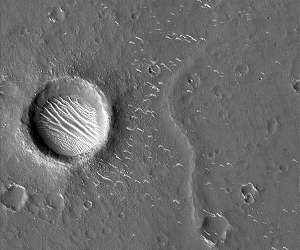Physicists led by the University of Iowa have learned how a type of aurora on Mars is formed. In a new study, the physicists studied discrete aurora, a light-in-the-sky display that occurs mostly during the night in the red planet’s southern hemisphere. While scientists have known about discrete aurora on Mars-which also occur on Earth-they did not know how they formed. That’s because Mars does not have a global magnetic field like Earth, which is a main trigger for aurora, also called the northern and southern lights on our planet.
Instead, the physicists report, discrete aurora on Mars are governed by the interaction between the solar wind-the constant jet of charged particles from the sun-and magnetic fields generated by the crust at southern latitudes on Mars. It’s the nature of this localized interaction between the solar wind and the crustal magnetic fields that lead to discrete aurora, the scientists find.
“We have the first detailed study looking at how solar wind conditions affect aurora on Mars,” says Zachary Girazian, associate research scientist in the Department of Physics and Astronomy and the study’s corresponding author.
“Our main finding is that inside the strong crustal field region, the aurora occurrence rate depends mostly on the orientation of the solar wind magnetic field, while outside the strong crustal field region, the occurrence rate depends mostly on the solar wind dynamic pressure.”
The findings come from more than 200 observations of discrete aurora on Mars by the NASA-led Mars Atmosphere and Volatile EvolutioN (MAVEN) spacecraft. One of the instruments used to make the observations, the Solar Wind Ion Analyzer, is led by Jasper Halekas, associate professor in the Department of Physics and Astronomy and a co-author on the study.
“Now is a very fruitful and exciting time for researching aurora at Mars. The database of discrete aurora observations we have from MAVEN is the first of its kind, allowing us to understand basic features of the aurora for the first time,” Girazian says.
The study, “Discrete Aurora at Mars: Dependence on Upstream Solar Wind Conditions,” was published online March 27 in the journal JGR: Space Physics. Contributing authors are Nick Schneider, Zachariah Milby, Xiaohua Fang, Sonal Kumar Jain, and Justin Deighan from the University of Colorado-Boulder; Tristan Weber from NASA Goddard Space Flight Center; Jean-Claude Gerard and Lucas Soret from the Universite de Liege in Belgium; and Christina Lee from the University of California-Berkeley.
Research Report:Discrete Aurora at Mars: Dependence on Upstream Solar Wind Conditions
Related Links
University of Iowa
Mars News and Information at MarsDaily.com
Lunar Dreams and more
|
We need your help. The SpaceDaily news network continues to grow but revenues have never been harder to maintain. With the rise of Ad Blockers, and Facebook – our traditional revenue sources via quality network advertising continues to decline. And unlike so many other news sites, we don’t have a paywall – with those annoying usernames and passwords. Our news coverage takes time and effort to publish 365 days a year. If you find our news sites informative and useful then please consider becoming a regular supporter or for now make a one off contribution. |
||
|
SpaceDaily Contributor $5 Billed Once credit card or paypal |
SpaceDaily Monthly Supporter $5 Billed Monthly paypal only |
|

![]()
Study reveals new way to reconstruct past climate on Mars
Melbourne, Australia (SPX) May 16, 2022
A study led by a Monash University geologist has provided fresh evidence for when high rates of erosion occurred throughout the history of Mars.
The findings, published in Geology date when climate was far more erosive in Mars’ past – with the implication that there were sustained periods of time when liquid water moved across the planet’s surface.
Scientists have long been keen to understand how Mars went from a state potentially more like modern Earth, to the desolate inhospitable place it … read more